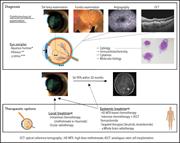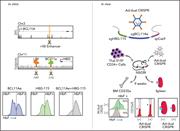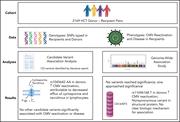Issue Archive
Table of Contents
BLOOD COMMENTARIES
REVIEW ARTICLE
Primary vitreoretinal lymphoma: a diagnostic and management challenge
Primary vitreoretinal lymphoma (PVRL) is a rare variant of central nervous system (CNS) lymphoma that arises in the eye without initial brain involvement. Soussain et al review the challenges of diagnosis and treatment of PVRL. Although local therapy preserves vision, 56% to 90% of patients develop CNS relapse. Approaches to primary and secondary therapy are discussed.
CLINICAL TRIALS AND OBSERVATIONS
Phase 1 study of ibrutinib and the CXCR4 antagonist ulocuplumab in CXCR4-mutated Waldenström macroglobulinemia
Clinical Trials & Observations
Brief Report
MYD88 is mutated over 90% of patients with Waldenström macroglobulinemia (WM), where it enhances Bruton tyrosine kinase (BTK)-related signaling, which can be targeted by BTK inhibitors, including ibrutinib. Concomitant CXCR4 mutations, found in 30% to 40% of WM patients, promote BTK resistance. Treon et al report that in a phase 1 trial of the CXCR4 antagonist ulocuplumab in combination with ibrutinib in CXCR4-mutant WM, therapy was well tolerated, with excellent response rates and a 2-year progression-free survival rate of 90%.
GENE THERAPY
Enhanced HbF reactivation by multiplex mutagenesis of thalassemic CD34+ cells in vitro and in vivo
In the switch from fetal to adult globin production, γ-globin expression is repressed by BCL11A and LRF/ZBTB7A, transcriptional repressors that bind the γ-globin promoter at distinct sites. Psatha and colleagues investigated the effect on γ-globin expression of combined mutation of the 2 binding sites with and without mutation of the BCL11A enhancer region. Mutating both binding sites decreases fetal hemoglobin (HbF) more than mutating either alone; however, combining mutation of either site with disruption of the BCL11A enhancer greatly increases HbF. This suggests that combining mutations may increase the clinical benefit of gene therapy for β-globin hemoglobinopathies.
IMMUNOBIOLOGY AND IMMUNOTHERAPY
Oncogene-induced maladaptive activation of trained immunity in the pathogenesis and treatment of Erdheim-Chester disease
LYMPHOID NEOPLASIA
Insertion of atypical glycans into the tumor antigen-binding site identifies DLBCLs with distinct origin and behavior
Glycosylation of the surface immunoglobulin (sIg) variable region in follicular lymphoma has been previously described. Chiodin and colleagues report that the same modification is seen in a subset of diffuse large B-cell lymphomas (DLBCLs), occurring in about 50% of GCB-type, but only 6% of ABC-type DLBCLs and conferring poor prognosis. The modification facilitates antigen-independent signaling B-cell receptor activation through interactions with microenvironmental lectins that can be specifically targeted with antibody. Thus, this modification identifies an aggressive form of DLBCL that may be targeted therapeutically.
Tumor cells in light-chain amyloidosis and myeloma show distinct transcriptional rewiring of normal plasma cell development
CME
Brief Report
It has been challenging to understand the pathophysiology that distinguishes between light-chain amyloidosis (AL) and multiple myeloma (MM), 2 plasma cell (PC) malignancies with strikingly different clinical presentations. In this month's CME article, Alameda et al define a “transcriptional atlas” of normal PCs, AL amyloidosis, MM, and monoclonal gammopathy of uncertain significance, identifying 13 different transcriptional patterns linking distinct PC dyscrasias to subsets of normal developing PCs, with diagnostic and prognostic implications.
MYELOID NEOPLASIA
GlcNAc is a mast-cell chromatin-remodeling oncometabolite that promotes systemic mastocytosis aggressiveness
Systemic mastocytosis (SM) is a KIT-driven hematopoietic neoplasm with a wide range of aggressiveness. Agopian et al analyzed plasma metabolomic profiles of patients with SM and identified N-acetyl-D-glucosamine (GlcNAc) as a powerful predictor of SM severity, suggesting a potential targetable pathway for treatment.
PLATELETS AND THROMBOPOIESIS
Dual role of EZH2 in megakaryocyte differentiation
Inactivating mutations in EZH2 are seen in myeloproliferative neoplasms, especially in association with myelofibrosis. Mazzi and colleagues used small molecules and short hairpin RNA to demonstrate a dual role for EZH2 in megakaryopoiesis. EZH2 downmodulates early megakaryocytic differentiation, and inhibition accelerates lineage commitment without increasing proliferation. However, it enhances megakaryocyte maturation, and its inhibition in late stages blocks maturation and decreases proplatelet formation.
RED CELLS, IRON, AND ERYTHROPOIESIS
Impairment of human terminal erythroid differentiation by histone deacetylase 5 deficiency
TRANSPLANTATION
Genetic variants associated with cytomegalovirus infection after allogeneic hematopoietic cell transplantation
Studies aimed at identifying genetic factors predisposing to cytomegalovirus (CMV) infection following hematopoietic cell transplantation (HCT) have varied widely and have not been validated. Casto and colleagues report a study of 117 previously reported variants in donor and recipient pairs of more than 2000 CMV-positive HCT recipients. Of the 117 candidate genes, they implicate only ABCB1, which encodes P-glycoprotein, in CMV reactivation. The gene variant results in reduced efflux of calcineurin inhibitors from donor lymphocytes, likely exerting its effect by increasing immune suppression.
LETTER TO BLOOD
BLOOD WORK
CONTINUING MEDICAL EDUCATION (CME) QUESTIONS
-
Cover Image
Cover Image
![issue cover]()
Lymphoma cells expressing oligomannose-type glycans on the surface immunoglobulin variable region (sIg-Mann) (red) cluster with cells expressing the lectin DC-SIGN (green). The specific sIg-Mann:DC-SIGN–mediated clustering can be blocked by an anti–DC-SIGN antibody. See the article by Chiodin et al on page 1570.
- PDF Icon Front MatterFront Matter
- PDF Icon Table of ContentsTable of Contents
- PDF Icon Editorial BoardEditorial Board
Advertisement intended for health care professionals
Email alerts
Advertisement intended for health care professionals













“Priority delivery” options for gene therapy